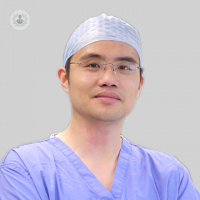Why regenerative medicine is the future of knee joint repair
Written by:For decades we’ve treated osteoarthritis in the knee by replacing the knee joint when other treatments are no longer effective. What if there’s a better way? Consultant orthopaedic surgeon and knee pain expert Professor Paul Lee explains that the growing field of regenerative medicine has the potential to change our approach to cartilage repair entirely – and make self-healing knee joints possible.

In the UK we carry out over 70,000 knee replacements every year. Knee replacement surgery is a routine operation and is extremely safe, with a very low risk of post-surgical problems.
Furthermore, in recent years we’ve developed sophisticated ways to ensure a perfect fit between your new joint and your leg. The 3D printing revolution has allowed us to create a custom knee joint for each patient, and using the latest robotic systems we can guide it into place with superhuman accuracy.
The limits of surgery
As sophisticated as these techniques are, however, fundamentally we’re working with metal and plastic – and these materials have limitations.
One problem is that our bodies are constantly changing. A knee joint that fits perfectly is unlikely to stay that way forever, and the vast majority have to be replaced within 15 years. Metal and plastic joints are not alive – and over time they suffer from wear and tear just like our original joint.
A bigger problem is the risk of infection. Patients with a knee replacement have to be particularly careful about spotting the signs of infection elsewhere in the body, as the risk of the artificial replacement becoming infected is serious. Like a splinter, it may be that one day your replacement is absolutely fine, and the next day infection sets in.
In my practice I see knee replacement as a last resort – once you cut away all of that living cartilage and bone, there’s no going back.
A much better option, in theory, would be to heal the damaged knee by encouraging the cartilage to regenerate.
Is cartilage damage inevitable?
Many people who have injured the cartilage in their knee can be treated effectively, with the cartilage growing back and normal leg function restored. But if you have osteoarthritis, the progressive wear and tear of the knee joint feels inevitable. Treatment is essentially palliative – we offer tips on strengthening the muscles to ease pressure and pain on the joint, and some may even inject steroids into the joint as a pain-relief mechanism, even though steroids are ultimately toxic to the cells in the joint.
Specialists such as myself have been challenging the notion that this is the only way to treat knee osteoarthritis. A growing medical speciality known as regenerative medicine seeks to find medicines that can encourage the cartilage in the knee to repair itself, avoiding the need for surgery.
Now, after many years of research, a number of promising substances have emerged, including stem cells, hyaluronic acid, lipogems and platelet-rich plasma. The use of these substances is known collectively as cell therapy because each of these substances act on the cells in our body. Depending on your situation, you might need more than one type of treatment. They can be injected directly into the knee joint in an outpatient setting, with little or no side effects. More research is needed to trial these substances more widely, but the early evidence is very promising.
Read more: How cell therapy works
Could this be the future of cartilage repair?
Regenerative medicine is growing in the UK with more and more orthopaedic and sports medicine clinics offering injection therapy alongside existing surgical options.
There is clearly momentum in regenerative medicine. The advantages are too great to ignore – from avoiding the risks and expense of invasive surgery, to preserving the natural mechanics of your knee and minimising the chances of infection. Providing our research is robust and we continue to refine the medicines we use, this is likely to be the future of cartilage repair.
What if I want to try it now?
With injection therapy now available in a number of clinics across the UK, patients are already starting to realise the benefits of regenerative medicine.
To make the most of this early opportunity and get the best possible treatment, it’s important to know how what a high-quality clinic looks like, especially as there are still many ways to carry out injection therapy. It’s also important to understand which of these new treatments may be most suitable for your situation. I will be covering these questions in a series of articles, where I explain each of the new treatments on offer in detail.


